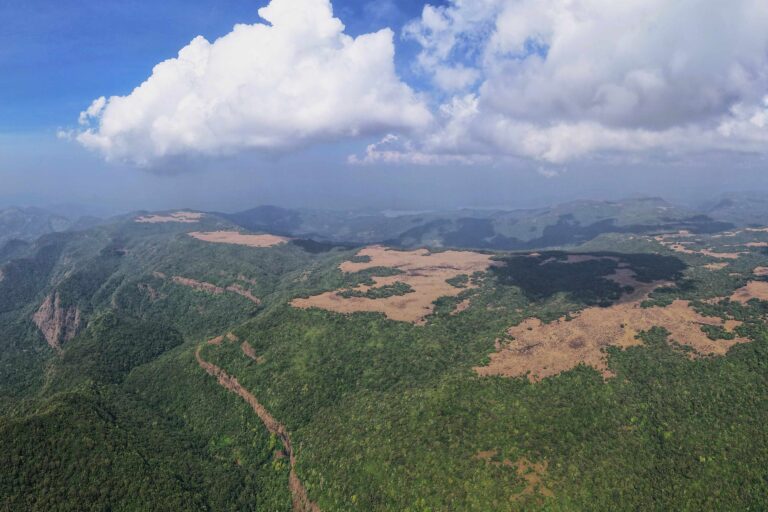- A new study that experimentally induced early snow-melting in eight alpine plants in Rohtang, found that future climate change could alter the functional composition of plants, thereby threatening their survival.
- Researchers say that the study helps better understand the response strategies of plant species at lower and higher elevations in the alpine region and would help in designing conservation strategies. They also call for longer-term studies for a more accurate prediction.
- Changes in the fauna and flora of alpine pastures and treeline or range shifts can impact the food security of the high-altitude communities in the long run.
Early snow-melting triggers complex responses in alpine plant species, influencing traits like leaf composition and resource acquisition strategies, a recent study finds.
The study analysed species’ response to experimentally induced early snow-melting (ES), by comparing responses under natural melting and early melt conditions, at Rohtang in the western Himalayas. Eight plant species from different elevations from 3,850 metres to 4,150 metres, each with unique strategies for getting resources, were examined over two years.
Rohtang is situated in the Pir Panjal mountain range in the western Himalayas, with alpine vegetation and its total annual precipitation is mostly in the form of snowfall. Rising global temperature and changes in rainfall and snowfall patterns affect the function and stability of alpine eco-regions with “‘cascading effects” from species to community levels, the study finds.

Adaptive potential of alpine plants
Previous studies on alpine plants and early snow-melting mostly focused on changes in seed production, plant cover, plant height, leaf area, leaf size and root growth of individual species, or on ecosystems of Europe and North America. A few looked at an entire eco-region such as the Himalayas. “An understanding of the responses of plant communities from other eco-regions, such as the Himalaya, is of immense use to prevent biodiversity loss under predicted climate change,” the authors note.
Under simulated early snow-melt conditions, the eight alpine plant species – a combination of six herbs, a deciduous shrub and a grass– were found to change their functional strategy at higher elevations, for example, increase their height and leaf area to persist in resource-limited conditions in a longer growing period, explains Amit Chawla, one of the study authors.
While the species at the lower elevations attempted to use fewer resources to survive in increasing environmental stress such as low soil water, due to early snow melt, species growing at higher areas had higher physiological tolerance and adaptive potential than lower elevation species, say Chawla and lead author Manish Sharma. For example, species in lower regions suffer higher cell membrane damage and produce fewer proteins under early snow melt conditions. “What makes this study unique is that we found that co-occurring species with different resource acquisition strategies respond differently to early snow melt at different elevations,” Chawla adds.
According to the authors these findings could be important as alpine eco-regions are home to various rare and endemic plant species, specially adapted to current climatic conditions. “The results of our study suggest that future climate change induces shifts in plant communities and functional composition. This could threaten the persistence of the species and community structure, in general, with the vulnerable species possibly heading towards local extinctions,” Chawla explains.
The study in Rohtang “provides novel insights about the functional traits of plant species,” say scientists from the International Centre for Integrated Mountain Development (ICIMOD) in Nepal. “It helps better understand the response strategies of plant species at lower and higher elevations in the alpine region, and “would help in designing and implementing conservation and restoration of alpine vegetation,” says Sunita Chaudhary, ecosystems services specialist at ICIMOD, who was not associated with this study.
This study by scientists from the Institute of Himalayan Bioresource Technology under the Council of Scientific and Industrial Research (CSIR) based in Himachal Pradesh state and the Academy of Scientific and Innovative Research, Ghaziabad, claims that it is one of the few to investigate in detail how ecological and physiological traits of alpine plant species are affected by the extended season length; how do these changes differ at contrasting heights; and how do different species in the same location respond to early snow melt. Their study also aimed to assess whether these responses to altered seasonality are specific to height or the plant’s functions.

Need for long-term studies
The scientists report that the ecological and physiological traits “can be significantly altered by future projected possible changes in growing season length due to early snow-melting.”
In general, the plant species’ responses to early snow-melting were complex, species-specific, and depended on the height at which they occur and how they acquire their nutrients such as nitrogen, phosphorus and other elements under altered light, temperature and soil conditions. Alpine species synthesise increased amount of vital substances essential to maintain their balance between salts and water and protect against physical and cell damage under early snow-melt conditions, their study published in Science of the Total Environment.
However, “since changes in snow cover and growing season length naturally fluctuate from year to year, longer-term studies are required to further support these inferences,” the study concludes. Although the findings provides a general understanding of how alpine plant species respond to early snow melt in the Himalayan alpine environment, yet the researchers were unable to address the issue of how different types of plants such as shrubs, herbs, grasses, and legumes, would respond.
Rohtang, whose land undergoes a drastic change form humid to semi-arid, is an ecologically sensitive zone facing “a high degree of ecosystem degradation” due to large tourist influx and climate change, Amita Chawla, one of the study authors from IHBT, tells Mongabay-India.
Due to climate change, alpine plants in the biodiversity-rich region are experiencing reduced snow, higher temperatures and early growing season.
A report by Chaudhary and colleagues at ICIMOD describes some of the observed negative impacts would include changes in distribution ranges of mammals in the Hindu Kush Himalayas that span eight countries from Afghanistan to Myanmar.
Major impacts on alpine vegetation at species and ecosystem levels, including changes in the timing of leaf-fall; and flowering, says Chaudhary. Meanwhile, studies in the Qinghai-Tibetan Plateau showed that greening and withering of plants was earlier by 15-18 days, while in arid regions such as the the Yungui Plateau, the early melting of snow and extreme drought led to significant changes in the start and end dates of the growing season. Another major change was in an upward shift of treeline from a few metres to 30 metres per decade in the Indian Himalayas in, for example, pines junipers and rhododendrons, explains Chaudhary.
Changes in the snowline and vegetation have led to species moving in search more favourable habitats, new assembling or gathering together of species, changes in genetic traits and local population of plants and trees, and in severe cases, even extinction. The upward shift of the snowline has negatively impacted the snow leopard habitats, which could even be reduced in Bhutan, India, Myanmar and Nepal by 2080. There could be changes in birds, decline in suitable bird habitats, and increased possibility of extinction, says Chaudhary. For example, warming can lead to pheasants such as satyr tragopan (Tragopan satyra) shift their habitats to higher elevations. There would be similar impacts on insects, with reduced numbers, upward shifts and emergence of new species.
Impacts of changes in alpine pastures
There could be two significant long-term effects of extension of the growing season of alpine plants due to early snow met, says Chawla. When the growing season starts early, they produce fewer flowers and have a lower survival rate due to the higher risk of frost. Only a few plant species might remain active and produce seeds in the full season under the future climatic conditions, and there is a possibility that such species could potentially become more common in the future, displacing the currently dominant species. Secondly, many alpine species also reproduce vegetatively and produce genetically identical plants, which slows down the process of adapting to new environmental conditions through genetic change. This too might result in changes in the species composition in the coming decades, he says.

There would be long-term implications for food security, positive and negative depending on the local context, on food security too, says Abid Hussain, interim area coordinator at ICIMOD.
Changes in the fauna and flora of alpine pastures and treeline or range shifts will impact the food security of the high-altitude communities who depend on subsistence agriculture and livestock, he says. “The nature of impacts depends on the local context.” Agriculture in areas closure to alpine pastures is characterized by single cropping periods from March to October, and communities in such areas significantly depend on livestock for their food consumption and some income.
“In general, upward shifts of vegetation have opened the door for communities to expand the area and diversity of crops,” say ICIMOD scientists. “On the other hand, changes in the fauna and flora in alpine pastures have also resulted in an increased incidence of human wildlife conflicts, leading to increased losses in agriculture.”
Similarly, there are varying effects of changes in the productivity of high-altitude livestock such as yak and goats, and on local food consumption. In the high-altitude areas of Pakistan livestock’s dependence on cultivated fodder has increased due to the degradation of palatable plant species in the pasture lands, “leading to a trade-off between food crops and fodder crops for subsistence farmers who already have only one cropping period. Overall, changes in alpine pastures have more negative impacts than the positive ones,” Hussain says.
Read more: Himalayas losing glaciers and snow: more hazards in the offing, a new study finds
Banner image: The Pir Panjal range. Photo by Sheetal Goel/Wikimedia Commons.














